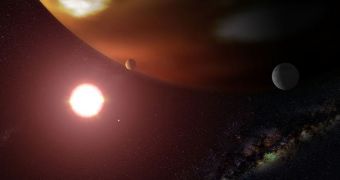Exoplanetary studies are a relatively new area of astronomy, having been set up only some years ago. But they have already produced viable results, and discovered more than 400 planets outside of our solar system. This was all achieved by using existing technologies, so experts say that the field will advance even more in coming years. As detection methods improve, and become even more susceptible to discovering exoplanets and exomoons, the small number of such bodies we know now could easily climb to a few thousands within decades.
The new investigation, called “Exoplanets – The search for planets beyond our solar system,” was developed by experts at the Institute of Physics (IOP) and highlights the methods that were used until now for exoplanet detection, and outlines possible strategies for promoting such discoveries in the future as well. But the paper also demonstrates how new technologies and approaches to space exploration provide a clearer picture of the fact that our galaxy may contain millions of solar systems. There are more than 100 billion stars in the Milky Way, and it’s estimated that a significant portion of them have exoplanets in their orbits.
“This report outlines exciting developments in detecting planets which might – just might – be able to support life in distant solar systems. It provides yet another illustration of how the techniques and knowledge provided by physics which help us to further our understanding of the Universe,” says the chief executive of the IOP, Dr. Robert Kirby-Harris. He also emphasizes the fact that a more advanced technology than back in the day currently allows for astronomers to discover exoplanets directly, via the visible light or infrared radiation they emit. Back in 1991, when the first such body was found, experts had to use radial velocity measurements for the same job.
Other than assessing the tug that an exoplanet exerts on its parent star, there are currently a large number of additional detection techniques that can be employed. Transit observation (measuring the dimming of a star's brightness as a planet passes in front of it), and nulling interferometry (where light waves received by several telescopes are combined to give a proportionately higher-resolution image), are methods equally as effective in detecting planets around other stars. In their quest for smaller, Earth-like planets, British researchers have, for example, taken interest in groundbreaking adaptive optics systems, such as the Gemini Planet Imager.

 14 DAY TRIAL //
14 DAY TRIAL //